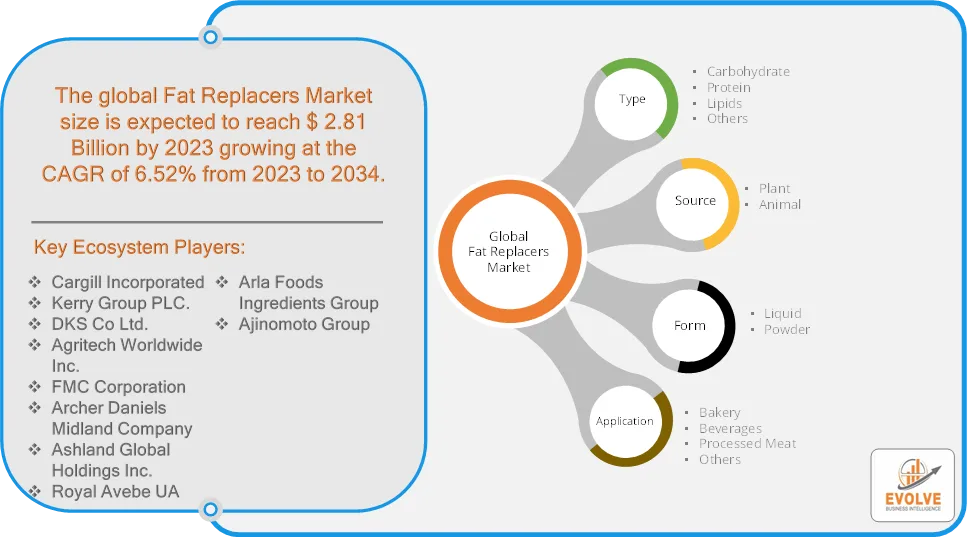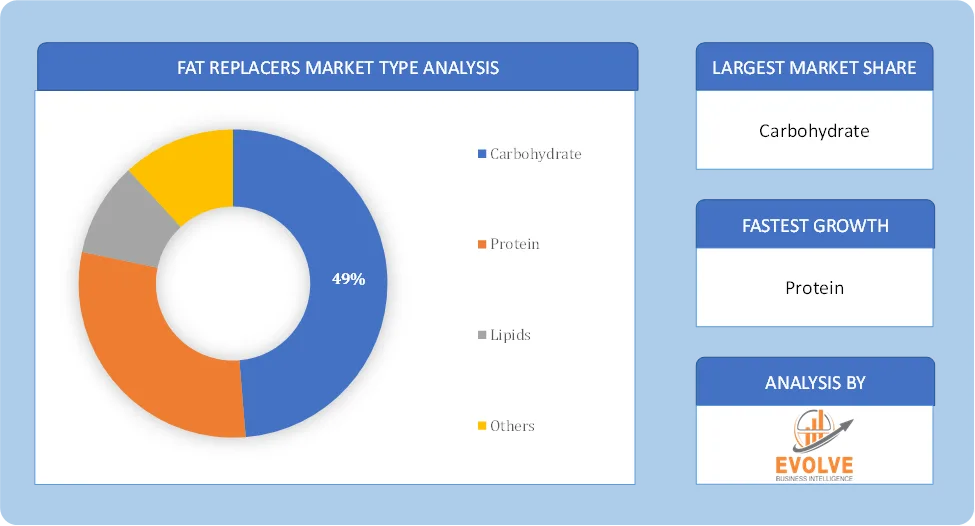Global Fat Replacers Market Forecast to Reach USD 9.36 Billion by 2034, Growing at a 6.52% CAGR

Evolve Business Intelligence has published a research report on the Global Fat Replacers Market, 2024–2034. The global Fat Replacers Market is projected to exhibit a CAGR of around 6.52% during the forecast period of 2024 to 2034.
Evolve Business Intelligence has recognized the following companies as the key players in the global Fat Replacers Market: Cargill Incorporated, Kerry Group PLC., DKS Co Ltd., Agritech Worldwide Inc., FMC Corporation, Archer Daniels Midland Company, Ashland Global Holdings Inc., Royal Avebe UA, Arla Foods Ingredients Group and Ajinomoto Group.

Market Highlights
The Global Fat Replacers Market is projected to be valued at USD 9.36 Billion by 2034, recording a CAGR of around 6.52% during the forecast period. The fat replacers market is experiencing significant growth, driven by increasing consumer health consciousness, rising obesity rates, and the demand for low-calorie and low-fat food products. Fat replacers are ingredients used in food manufacturing to mimic the properties of traditional fats, such as texture, mouthfeel, and flavor, while reducing the overall fat and calorie content.
Increasing awareness of health issues related to high-fat diets, such as obesity, cardiovascular diseases, and high cholesterol, is driving consumers to opt for low-fat and low-calorie food options and the rising preference for weight management and healthier lifestyles is boosting the demand for food products containing fat replacers.
Download the full report now to discover market trends, opportunities, and strategies for success.
Segmental Analysis
The global Fat Replacers Market has been segmented based on Type, Source, Form and Application.
Based on Type, the Fat Replacers Market is segmented into Carbohydrate, Protein, Lipids, Others. The Carbohydrate segment is anticipated to dominate the market.
Based on Source, the global Fat Replacers Market has been divided Plant and Animal. The Plant segment is anticipated to dominate the market.
Based on Form, the global Fat Replacers Market has been divided into Liquid and Powder. The Powder segment is anticipated to dominate the market.
Based on Application, the global Fat Replacers Market has been divided into Bakery, Beverages, Processed Meat, Others. The Bakery segment is anticipated to dominate the market.
Regional Analysis
The Fat Replacers Market is divided into five regions: North America, Europe, Asia-Pacific, South America, and the Middle East, & Africa. North America is largest market due to strong consumer demand for low-fat and functional foods. Presence of major food manufacturers and ingredient suppliers investing in fat substitute innovations and has stringent FDA regulations encouraging reformulation of processed foods with healthier alternatives. Europe region, is second-largest market, driven by strict EU food labeling laws and consumer preference for natural ingredients. Demand for low-calorie dairy products, baked goods, and meat substitutes is increasing and has strong market for protein-based and carbohydrate-based fat replacers. In Asia-Pacific region, China led the market in 2024 due to the increasing preference for healthy food options. India and other Southeast Asian countries are also witnessing significant growth. Rapid urbanization, changing consumer lifestyles, rising disposable incomes, and a growing inclination towards quality-oriented and healthy food options are driving significant growth. Increasing demand for fat-free dairy items and convenient foods. Growing awareness of clean-label products and healthy ingredients. Latin America region, Brazil, Mexico, and Argentina leading in fat replacer adoption. Emerging market with increasing demand for low-calorie foods and healthier snacks. Governments introducing nutritional labeling laws to curb obesity rates. Middle East and Africa region is slow but steady growth, driven by urbanization and rising disposable income. Government initiatives promoting healthier eating habits and increasing adoption of low-fat dairy and processed foods.


